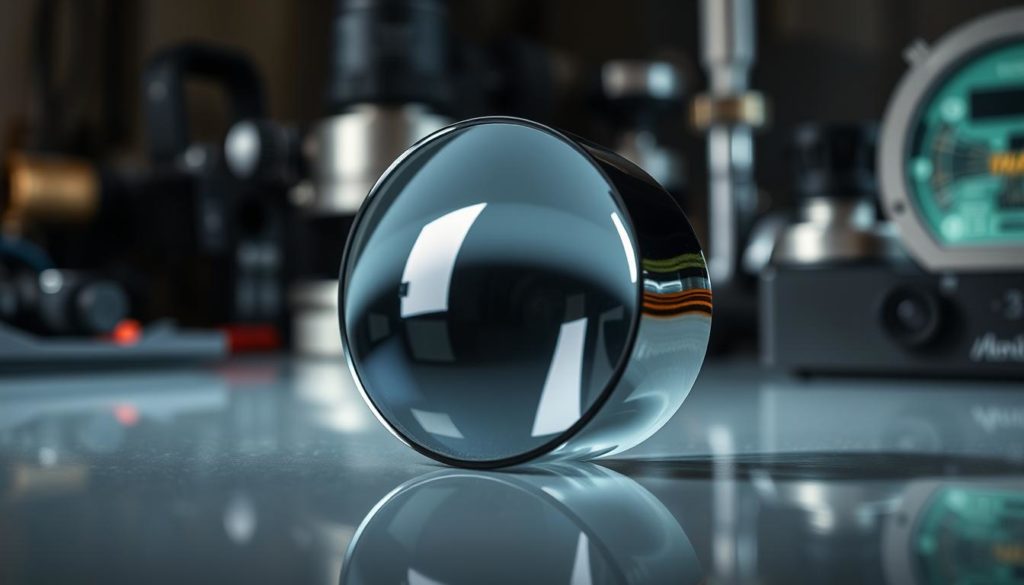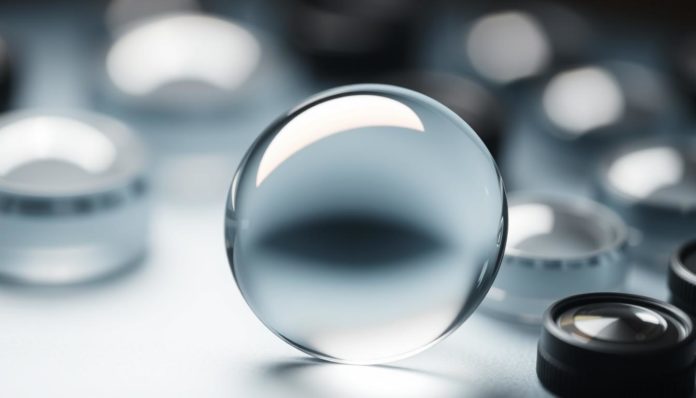Did you know the global market for aspheric lenses was worth $14.7 billion in 2020? It’s expected to grow even more in the future. This shows how important these lenses are in optical technology and vision enhancement.
Aspheric lenses are made to improve vision by reducing optical errors. They are different from traditional spherical lenses because they offer clearer vision. This makes them essential in many areas, from eyeglasses to camera lenses. The aspheric lens advantages are being used more than ever before.
In this article, we’ll look into what makes aspheric lenses unique. We’ll also explore their benefits. We’ll talk about their design, how they’re made, and how they help improve vision in various fields. Get ready to learn about the world of aspheric lenses and their key role in modern optics.
Introduction to Aspheric Lenses
Aspheric lenses have changed the world of optical lenses. They are different from traditional spherical lenses. Aspheric lenses have a complex shape to reduce optical errors and make images clearer.
This design is key in modern eye care. It gives wearers a wider field of vision and better comfort.

Overview of Lens Types
There are many types of optical lenses for different uses. Let’s compare spherical and aspheric lenses:
| Type of Lens | Design | Applications |
|---|---|---|
| Spherical Lenses | Uniform curvature | Basic eyeglasses, simple optical devices |
| Aspheric Lenses | Complex curvature | Advanced eyeglasses, cameras, modern optics |
Importance in Modern Optics
Aspheric lenses are very important in modern optics. Their unique shape improves performance in many areas. This includes better eye care and camera images.
The introduction of aspheric lenses has greatly influenced lens design and making. It ensures optical products are precise and efficient.
What Are Aspheric Lenses?
An aspheric lens has a special shape that lets it manage light well. Unlike regular lenses, it doesn’t distort images as much. This is because of its unique optical design and lens curvature.

The design of an aspheric lens changes gradually from the center to the edges. This helps reduce optical problems like spherical aberration. It makes images clearer.
- Improved image clarity due to reduction in distortions
- Enhanced accuracy in optical design
- Efficient lens curvature management
Aspheric lenses are great for many uses, like eyeglasses and precise tools. Knowing about them helps us see their big role in today’s optics.
| Characteristic | Aspheric Lenses | Spherical Lenses |
|---|---|---|
| Design | Non-spherical curvature | Spherical curvature |
| Distortion | Reduced | Higher |
| Application | Eyeglasses, Cameras | Basic lenses |
In summary, aspheric lenses are known for their advanced optical design and how they handle lens curvature. These features improve how we see things in many areas.
Types of Aspheric Lenses
Aspheric lenses are made in many forms to meet different needs. Let’s explore some key aspheric lens types today.
Diffractive Aspheric Lenses
Diffractive aspheric lenses mix refractive and diffractive optics. They can handle complex light tasks in one small package. These lenses are great for reducing color issues and improving light use.
Hybrid Aspheric Lenses
Hybrid lenses have both aspheric and spherical parts. This mix offers the best of both worlds. They give better image quality and less optical errors. Hybrid lenses are used in top-notch imaging systems where accuracy is key.
Custom Aspheric Lenses
Custom lenses are made for special needs. Custom aspheric lenses are designed for unique optical problems. They are crucial in advanced medical tools and research equipment.
| Lens Type | Key Features | Common Applications |
|---|---|---|
| Diffractive Aspheric Lenses | Combines refractive and diffractive elements | Minimized chromatic aberrations, improved light efficiency |
| Hybrid Aspheric Lenses | Integrates aspheric and spherical surfaces | High-performance imaging systems |
| Custom Aspheric Lenses | Tailored to specific optical needs | Advanced medical instruments, specialized research tools |
Benefits of Aspheric Lenses
The benefits of aspheric lenses are many, making them a great choice for better vision. Unlike regular lenses, aspheric lenses have a more complex shape. This helps in reducing many optical distortions.
Enhanced Vision Clarity
One key benefit of aspheric lenses is better vision clarity. They cut down on spherical aberrations, a common issue in regular lenses. This can cause blurry or distorted vision. Aspheric lenses, with their flatter design and precise shape, give sharper and more accurate vision correction.
Reduced Optical Aberrations
Another big benefit of aspheric lenses is their ability to correct aberrations. They are made to lessen or get rid of distortions like spherical aberration and coma. This leads to better image quality and a wider field of view. They are perfect for eyeglasses, cameras, and telescopes.
Understanding Aspheric Lens Design
Aspheric lens engineering has changed the optics world. It offers better image quality and less distortion. These lenses need careful design and advanced making methods.
Design Principles
Aspheric lenses are made with special design rules. They have surfaces that curve more at the edges than the middle. This helps control optical problems, making images clearer.
Good aspheric lens design tackles several key issues. It aims to:
- Reduce spherical aberrations
- Fix distortions
- Improve optical quality
This design ensures lenses work well in cameras, medical tools, and glasses.
Manufacturing Techniques
Making aspheric lenses needs advanced methods. These include:
- Precision glass molding
- Single-point diamond turning
- Injection molding for plastic lenses
Each method has its benefits. Glass molding is best for quality, while injection molding is cheaper for making lots. Aspheric lens making needs strict quality checks and the latest tech.
By mixing these design rules with new making ways, the field keeps improving lens design.
Common Uses of Aspheric Lenses
Aspheric lenses are used in many fields because they reduce optical errors and improve image quality. Let’s look at some of their main uses.
Eyeglasses
Aspheric lenses in eyewear have a flatter shape. This reduces distortion and improves side vision. They make glasses look better and help people see clearer.
These lenses cut down on unwanted distortions. This lets users see the world more naturally.
Cameras
In camera optics, aspheric lenses are key for top-notch photos. They fix various aberrations, making images sharper and more detailed.
They’re used in small cameras to get clear pictures without adding weight. This is great for pros who need quality and portability.
Medical Instruments
Aspheric lenses are also vital in medical imaging. They help doctors get clearer images in tools like endoscopes.
The precision of aspheric lenses is essential for accurate diagnoses and care. They help doctors see inside the body better. This leads to more precise treatments.
Leading Aspheric Lens Manufacturers
Looking for the best aspheric lens providers? Several companies are at the top, known for innovation, quality, and market presence. They keep improving lens production, bringing new technology and top performance.
Nikon, Canon, and Carl Zeiss are leading the way. These famous brands offer advanced optical solutions and invest heavily in research and development. Their work has greatly enhanced aspheric lens imaging and performance.
Here’s a look at some top manufacturers, showing what makes them stand out:
| Manufacturer | Specialization | Notable Products |
|---|---|---|
| Nikon | Precision Optics | Nikkor Lenses |
| Canon | High-Resolution Imaging | EF and RF Lenses |
| Carl Zeiss | Medical and Consumer Optics | Zeiss Planar T* |
These companies offer the best aspheric lenses and set high standards in technology and design. They invest in innovation, helping the optical industry grow. This growth meets the needs of many fields, from electronics to medical tools.
In short, choosing these industry leaders for your lens needs means getting top-quality products and the latest technology.
Materials Used in Aspheric Lenses
Choosing the right materials is key for making top-notch aspheric lenses. The materials used can greatly affect how well the lenses work and how long they last. There are mainly two types: optical glass and high-index plastics.
Glass Materials
Optical glass is often the go-to for high-quality aspheric lenses. It’s tough and precise, making it perfect for clear vision. Its low dispersion and high transparency mean less distortion, making it great for photography and scientific tools.
Plastic Materials
High-index plastics are also crucial for aspheric lenses. They’re light and flexible, allowing for thinner lenses without losing quality. Plus, they’re more resistant to damage than glass, making them good for everyday use and gadgets.
| Feature | Optical Glass | High-Index Plastics |
|---|---|---|
| Durability | High | Medium |
| Weight | Heavy | Light |
| Flexibility | Low | High |
| Cost | Expensive | Affordable |
| Application | Photography, Scientific Instruments | Eyeglasses, Consumer Electronics |
In short, picking the right material for aspheric lenses depends on what you need them for. Whether it’s optical glass for precision or high-index plastics for durability, each has its own benefits for different uses.
Comparing Aspheric vs Spherical Lenses
Understanding the differences between aspheric and spherical lenses is key. This section will explore their design, performance, and cost. We’ll see how these lenses compare.
Design Differences
Aspheric lenses have a unique shape, unlike spherical lenses. Spherical lenses have a simple curve, which can cause some optical issues. Aspheric lenses, with their complex shape, reduce these problems and improve image quality.
This design difference is crucial for many uses, from eyeglasses to camera lenses. It makes a big difference in how well they work.
Performance Comparison
Aspheric lenses usually perform better than spherical ones. They reduce optical problems and make images clearer. This means sharper focus and less distortion.
This is especially true for eyeglasses and camera lenses. Aspheric lenses offer a better visual experience. So, in a lens comparison, aspheric lenses often win for their precision and clarity.
Cost Considerations
The cost of aspheric and spherical lenses is a big factor for buyers. Aspheric lenses are pricier because of their complex design. But, their better performance might be worth the extra cost for many.
Choosing between aspheric and spherical lenses depends on your needs and budget. It also depends on what you need from your lenses.
| Aspect | Aspheric Lenses | Spherical Lenses |
|---|---|---|
| Design | Complex, variable curvature | Simplified, constant curvature |
| Performance | High, minimal aberrations | Moderate, potential for distortions |
| Cost | Higher | Lower |
| Applications | Precision optical tools, advanced eyeglasses | General-purpose optics, standard eyeglasses |
Buying Guide for Aspheric Lenses
When looking to buy an aspheric lens, it’s key to know what to look for. This guide offers aspheric lens buying tips to help you pick the right one. It also helps you see if it’s a good value for your money.
Choosing the Right Lens
Choosing the right aspheric lens takes a few steps. First, figure out where you’ll use it, like in glasses, cameras, or medical tools. Look at what top brands like Zeiss and Nikon offer. Knowing about focal length and aperture helps you choose wisely.
- Identify the primary application of your lens.
- Research top aspheric lens manufacturers.
- Compare key specifications like focal length and aperture.
- Read user reviews and expert opinions.
- Consult with an optician or a camera specialist if required.
Price and Quality Factors
Finding the right balance between price and quality is crucial. Prices differ based on brand, material, and tech used. High-quality lenses from well-known brands usually offer better value assessment. They are clearer and last longer.
| Brand | Material | Price Range | Quality Rating |
|---|---|---|---|
| Zeiss | Glass | $300 – $800 | 9/10 |
| Nikon | Plastic | $200 – $600 | 8/10 |
| Sony | Glass | $250 – $700 | 8.5/10 |
By thinking about these points, you can choose a lens that’s both affordable and high-quality. This ensures you get great performance and reliability.
Care and Maintenance of Aspheric Lenses
To keep your aspheric lenses in top shape, you need to take good care of them. We’ll cover important lens care tips, like how to clean and store them. By following these steps, you can keep your lenses looking great for a long time.
Cleaning Tips
Cleaning your lenses regularly is key to keeping them clear and working well. Use a microfiber cloth made for optical lenses to avoid scratches. Don’t use paper towels or tissues, as they can harm your lenses.
For a deeper clean, use lens cleaning solutions that match your aspheric lenses. Put a few drops on the cloth and wipe the lens in a circular motion. Gentle and consistent cleaning is essential for your lenses.
Storage Guidelines
Storing your lenses right is important to prevent damage and keep them lasting longer. Always put your lenses in a protective case when you’re not wearing them. This protects them from dust and knocks.
Make sure the storage case is in a cool, dry spot, away from sunlight. Too much heat or moisture can harm your lenses. By following these storage tips, you’ll keep your lenses in great condition for years.
FAQ
What are aspheric lenses?
Aspheric lenses have a unique shape that cuts down on distortions. This makes images clearer. They’re used in many optical products to improve vision.
What are the benefits of aspheric lenses?
Aspheric lenses give you sharper images and less distortion than regular lenses. They’re great for clear vision.
How are aspheric lenses different from spherical lenses?
Aspheric lenses have a special curve that reduces distortions. Spherical lenses have a constant curve. This makes aspheric lenses better for vision.
What types of aspheric lenses are available?
You can find diffractive, hybrid, and custom aspheric lenses. Each type is made for different uses.
How are aspheric lenses designed?
Designing aspheric lenses involves advanced engineering and manufacturing. This creates their unique shape and high performance.
Can I use aspheric lenses in my eyeglasses?
Yes, aspheric lenses are great for eyeglasses. They help people with high prescriptions see clearer.
Are there leading manufacturers of aspheric lenses?
Yes, brands like Carl Zeiss, Nikon, and Canon make top-notch aspheric lenses. They’re used in many optical products.
What materials are used to make aspheric lenses?
Aspheric lenses can be glass or high-index plastic. The material affects the lens’s performance, weight, and durability.
Is there a buying guide for aspheric lenses?
When buying aspheric lenses, think about the type, material, price, and quality. Finding the right balance is key.
How should I care for my aspheric lenses?
Clean and store your aspheric lenses right to keep them in good shape. Use the right cleaning solutions and soft cloths. Store them in a protective case to avoid damage.


